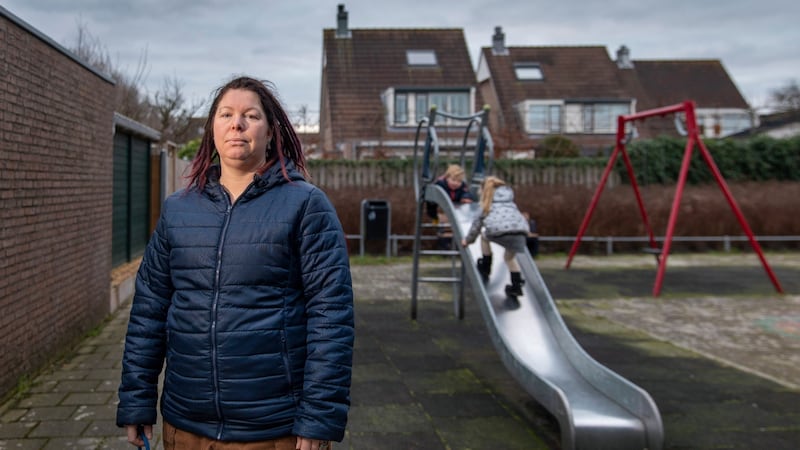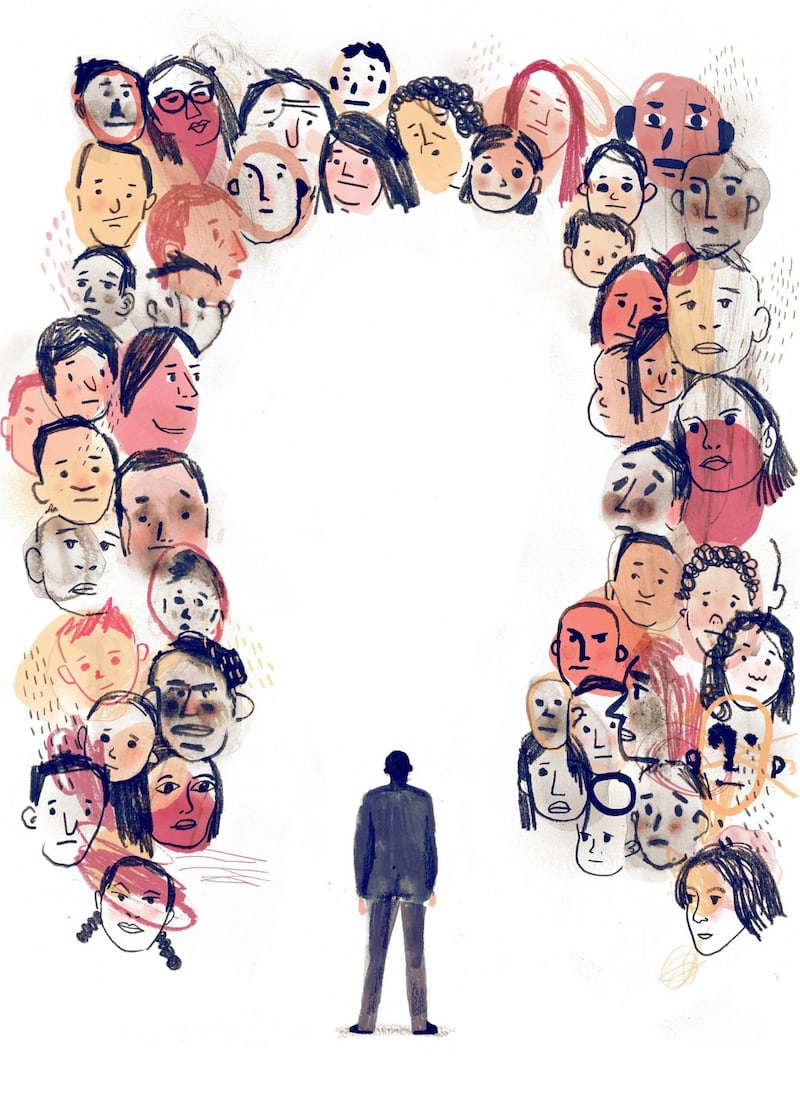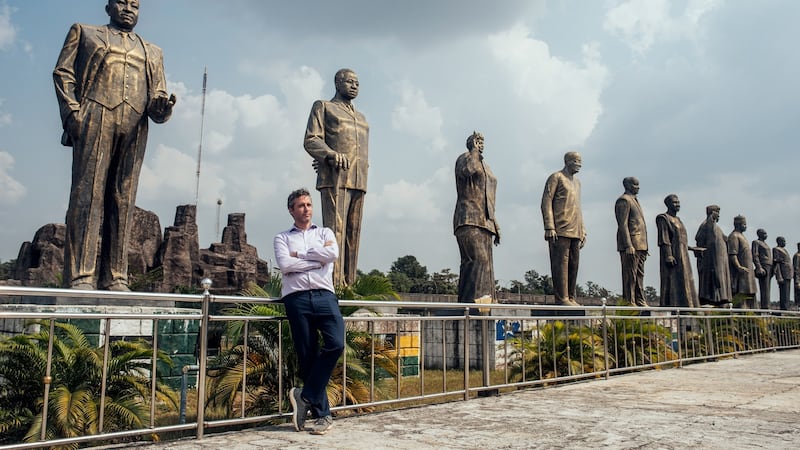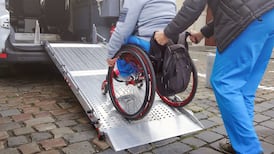In 2015, Vanessa van Ewijk, a carpenter in the Netherlands, decided that she wanted to have a child. She was 34 and single, and so, like many women, she sought out a sperm donor. She considered conceiving through a fertility clinic, but the cost was prohibitive for her. Instead, she found an ideal candidate through a website called Desire for a Child, one of a growing number of online sperm markets that match candidate donors directly with potential recipients. Van Ewijk was drawn to one profile in particular, that of Jonathan Jacob Meijer, a Dutch musician in his 30s.
Meijer was handsome, with blue eyes and a mane of curly blond hair. Van Ewijk liked how genuine he appeared. “I spoke to him on the phone and he seemed gentle and kind and well-behaved,” she said. “He liked music, and he talked about his thoughts on life. He didn’t come on strong in any sense. He seemed like the boy next door.”
About a month later, after some back-and-forth, she and Meijer arranged to meet at Central Station, a busy railway hub in The Hague. He provided her with his sperm, and in return she paid him €165 and covered his travel costs. Months later she gave birth to a daughter – her first child and, Meijer told her, his eighth. (Meijer declined to be interviewed for this article but did answer some questions by email, and stated that he did not grant permission for his name to be published.)
In 2017, when she decided to conceive again, she reached out once more to Meijer. Once again he met with her and, for a similarly modest fee, provided a container of his semen; once again she became pregnant, and gave birth to a boy. Even before then, however, van Ewijk had learned some unsettling news. She had connected on Facebook with another single mother who also had used Meijer as a donor, and who told her that, according to an investigation in 2017 by the Dutch Ministry of Health, Welfare and Sport, he had fathered at least 102 children in the Netherlands through numerous fertility clinics, a tally that did not include his private donations through websites.
How do I tell my kids that they could possibly have 300 siblings?
Van Ewijk wanted her children to be full siblings, so she still wanted Meijer to be the donor. Nonetheless, she was alarmed. The Netherlands is a small country, home to 17 million people; the more half-siblings there are in the population who are unknown to one another, the greater the odds that two of them might meet unwittingly and produce children of their own – children with a heightened risk of carrying hereditary defects.
Furious, van Ewijk confronted Meijer. He admitted that he had produced at least 175 children and conceded that there might be more. “He said, ‘I’m just helping women make their biggest wish come true,’” van Ewijk recalled. “I said: ‘You’re not helping anymore! How do I tell my kids that they could possibly have 300 siblings?’” She may have only known the half of it.
The perils of swiping right
The first child of in vitro fertilisation was born in 1978 and in the decades since, sperm donation has become a thriving global business, as fertility clinics, sperm banks and private donors have sought to meet the demand of parents eager to conceive.
As an industry, however, it is poorly regulated. A patchwork of laws ostensibly addresses who can donate, where and how often, in part to avoid introducing or amplifying genetic disabilities in a population. In Germany, a sperm-clinic donor may not produce more than 15 children; in the United Kingdom the cap is 10 families of unlimited children. In the Netherlands, Dutch law prohibits donating anonymously, and nonbinding guidelines limit clinic donors to 25 children and from donating at more than one clinic in the country. In the United States there are no legal limits, only guidelines from the American Society for Reproductive Medicine: 25 children per donor in a population of 800,000.
Regulation is even more scarce internationally. There is little to stop a sperm donor from donating at clinics in countries other than his own, or at global agencies like Cryos International, the world’s biggest sperm clinic, in Denmark, which ships semen to more than 100 countries.
“There’s nothing in the US or anywhere that would keep a donor from donating at more than one sperm bank,” said Wendy Kramer, a co-founder and the executive director of the Donor Sibling Registry, an organisation in the United States that supports donor families. “The sperm banks claim that they ask the donor if they’ve donated anywhere else, but nobody knows if they really do.”

And few if any laws govern private donations, of the kind that van Ewijk and Meijer arranged through the internet. Through these gaps, several cases have emerged of donors who have fathered scores of children or more, and of grown children discovering, often through social media, that they have not just a handful of half-siblings but dozens of them.
In 2019, the Dutch Donor Child Foundation, an advocacy group that facilitates legal and emotional support for donor-conceived people and their families and helps search for biological relatives, determined through DNA testing that Dr Jan Karbaat, a fertility specialist who died in 2017, had secretly fathered at least 68 children, born to women who visited his clinic near Rotterdam.
At least one sperm donor in the Netherlands, known as Louis, is thought to have more than 200 offspring, many of whom are unaware of one another. Six years ago Ivo van Halen, a 36-year-old Dutch information technology consultant, learned that he was among them. Since then, he has managed to connect directly with 42 of his half-siblings.
“It’s been a shock to learn how to integrate 42 brothers and sisters into your life,” van Halen said in an interview. “There are no books on how to do that. Our group is at 70 known children already, and getting new matches every month.” Some of his half-siblings have encountered each other multiple times on Tinder, the dating app. One half-brother, Jordy Willekens, who lives in The Hague, matched online with four half-sisters. “Once, I swiped on a sister and she swiped right on me at the same time,” Willekens said.
The group keeps a list of potential siblings to refer to before going on a date. Willekens, who is now in a relationship, said he had been very careful when dating: “I have a very trained eye by now.”
‘It’s dangerous for the children’
Some sperm donors, like Karbaat, donate surreptitiously and illegally, leaving their identities and the scale of their activity to be discovered many years later by their offspring, often as a shock. Other donors are openly profligate. Ari Nagel, a math professor in New York, donates exclusively online and directly with recipients; he has been nicknamed the “Target Donor” because he sometimes meets women in public spots, such as Target stores, to hand off his sperm. He told The New York Times that he had 76 biological children. Simon Watson, a donor in the United Kingdom who regularly updates his Facebook site with photos of his offspring, told the BBC in 2016 that he had at least 800 children around the world.
Meijer appears to have adopted both approaches, registering at more clinics than is recommended while also donating privately. In 2017, after confronting Meijer, van Ewijk notified the Dutch Donor Child Foundation that he had many more children than he had initially revealed, and that he had been donating sperm at several clinics. The group already knew of him, from other mothers with the same complaint.
The foundation soon determined that Meijer had privately fathered at least 80 children in the Netherlands, in addition to the 102 that the Ministry of Health, Welfare and Sport had identified through 11 clinics in the country. The government ordered all Dutch sperm clinics to stop using Meijer’s semen.
(Because of Dutch privacy laws, the government has not publicly named Meijer as the donor in question. However, in an email to The Times, a spokesman for the health ministry confirmed his identity. “Donors must sign an agreement with their clinic that they don’t donate sperm at other clinics,” Gerrit-Jan KleinJan wrote. “The sperm donor you are writing about made this agreement as well. Nevertheless, he donated at more sperm banks resulting in 102 babies.”)
It's disgusting and I want it to stop
Van Ewijk subsequently became friends with two other Dutch mothers who had used Meijer as a donor. The two worked together in the same preschool and realised they shared the same donor after noticing that their children, both 9, looked alike.
The two women, who requested anonymity to protect their children’s privacy, said that they in turn knew several other women in their city, Almere, who had used Meijer as a donor. One mother expressed concern that some of these half-siblings could accidentally meet and have a relationship.
“It’s disgusting and I want it to stop,” she said. “It’s dangerous for the children. There are more brothers and sisters in Almere, and they can fall in love. It’s not good.”
Tim Bueter, a lawyer in the Netherlands who represented the families in the case of Karbaat, said he had been contacted by 12 mothers who had used Meijer’s sperm. They wanted to know if there was any legal action they could take against him. Bueter said there was very little they could do, as no laws applied.
“It was stunning to hear that something like this is going on,” Bueter said. “The children are the victims in this case. Something has to be done to stop him. The only thing these women can do is go to the public and hope everyone in the world knows not to use this guy as a sperm donor.”
13 countries or more
Joëlle de Boer, a volunteer and the international contact person at the Dutch Donor Child Foundation, has been tracking Meijer’s activity. According to her research, he has been travelling throughout Europe, Scandinavia and Ukraine for several years, donating sperm since 2007 at various clinics as well as privately on the internet.
“Two weeks ago I went to donate in Kyiv at Biotexcom clinic,” he wrote on Facebook in June 2017, referring to the BioTexCom Center for Human Reproduction in Ukraine, which uses donated sperm for in vitro fertilisation and surrogacy. “The lady I helped used an egg-donor from Ukraine, which will be fertilised with my sperm. I must say this was one of the best experiences I have with clinics!”
De Boer has also been tabulating Meijer’s online presence, including on eight private donation websites in Germany, Italy and the Netherlands. On one site, he advertised himself as a blond “musical Viking donor.” She shared with The Times screen shots of private-donation sites on which a donor with Meijer’s photo accompanied false names, including “Lukas” and “Martijn.” Asked to comment, Meijer said in an email, “I never ever donated under false names.”
In addition, Meijer has registered with at least one international sperm bank, Cryos, which does not set an overall limit on how many children a donor may generate, although it claims to adhere to the limits set by each country to which it donates. Still, with each bank exporting to scores of countries, a single donor could potentially produce hundreds or even thousands of children around the world.
Moreover, unlike sperm banks in the Netherlands, which prohibit anonymous donation, international sperm banks commonly register donors under an alias or a number. Also, they rely on clients to voluntarily report the births of their children when keeping track of sperm donor offspring, and that tally is not always accurate. And there is no international registry of sperm donors, so a recipient has no easy way of knowing where else her donor might have donated or how many half-siblings her children might have.

De Boer said she has been in touch with mothers who have had children by Meijer in Australia, Italy, Serbia, Ukraine, Germany, Poland, Hungary, Switzerland, Romania, Denmark, Sweden, Mexico and the United States. Several were in contact with the two Dutch mothers who are friends of van Ewijk’s, and they confirmed their accounts with this reporter.
A German woman told The Times that she acquired Meijer’s sperm through Cryos; although he donated under an alias, she was able to figure out his real name. In 2019 she received a letter from Cryos notifying her that her donor “has donated in countries outside of Denmark, therefore breaching the contract he had with Cryos to donate exclusively to our sperm bank.”
The letter added, “This means that the donor has allegedly achieved more pregnancies than the pregnancies registered in our system.” The company also notified Danish health authorities, the letter said, and had stopped distributing his semen.
In an email, Meijer said he did not recall being told that he was barred from donating at other clinics: “Clinics did intensive health and genetics screening and interviewing, and I passed them all, but I do not remember this procedure clearly to say anything about it.” In a second email he said, “There were no strict agreements amongst sperm banks (up until recently) to check if donors hadn’t been donating elsewhere.”
Reached for comment, Peter Reeslev, chief executive of Cryos, insisted that a Cryos donor could not have signed up without being aware of the exclusivity clause. “NO,” he wrote in an email. “Donors sign and commit in contractual terms to not donate in any other tissue establishments than Cryos before and undertake not to donate sperm to other sperm banks/tissue centers in the future as well.”
He added, “On a general level, Cryos disassociates itself from any form of serial sperm donation due to the importance of not exceeding national pregnancy quotas” in each country to which they send sperm.
Exactly how many donor children Meijer has around the world is impossible to say. But Ties van der Meer, director of the Dutch Donor Child Foundation, and his colleagues have calculated that if Meijer’s known pattern of clinic and private donation was any indicator, the number could run to several hundred, even 1,000.
In an email, Meijer dismissed that conclusion. “I have approximately 250 children,” he said. “Assumptions of 1,000 are ridiculous. I am disappointed by the obsession of the numbers. I became a donor not for any numbers but out of love to help parents with realising their dream. I cannot understand how anyone can only focus on numbers and see my donor children as a number.”
Creating legal barriers
To combat the serial-donor problem, officials in the Netherlands are implementing various measures, including the creation of a central registry for sperm donors, to prevent men from donating at several clinics at the same time, said Dr Monique H Mochtar, chair of the Gamete Donation Special Interest Group. Moreover, because of Meijer, the recommended limit of 25 children per donor at sperm clinics is expected to be amended into law this spring, restricting one donor to 12 mothers nationally.
But challenges and loopholes remain at the international level. “The lack of any regulatory and legislative bodies for the international fertility industry lets companies claim and do whatever they want,” van der Meer, of the Dutch Donor Child Foundation, said. “We need international legislation and help for all families that have been hurt by the actions of donors like this man.”
No sane person would want 100 children or more
The issue of serial sperm donation has been recognised in other countries as well. Christina Motejl, a lawyer in Berlin, is a member of Donor Offspring Europe, a network of organisations of donor-conceived adults in Europe. She said that the group was concerned about donors who travel around Europe trying to father as many children as possible.
“It’s kind of disgusting in a narcissistic way,” she said. “No sane person would want 100 children or more. The big question is why? These men want confirmation that they’re a great guy and everybody wants them.”
Judith Daar, who leads the ethics committee of the American Society for Reproductive Medicine, said that although there is often a reluctance to regulate assisted reproduction more strictly than natural conception, it might be appropriate in extreme cases, including in Meijer’s, to impose limits on the number of offspring that any one donor may have.
She noted that men who donate through social media, eschewing the paperwork of a sperm bank or a doctor, could end up surprised by devastating legal consequences. “Donors should be aware that, depending on state law, they may be deemed legal parents of any resulting offspring,” said Daar, who is also the dean at Northern Kentucky University’s Chase College of Law and the author of “The New Eugenics: Selective Breeding in an Era of Reproductive Technologies.” She also encouraged women to verify a donor’s health and genetic testing through qualified experts, rather than taking the donor’s word for it.
The donor lifestyle
What compels a sperm donor to donate so profusely? In 2013, a journal article by the Donor Sibling Registry identified three main motives, at least for average donors: money, generosity and the desire to pass along their DNA. “I think you have to look at No 3, passing on their genes to have children,” said Kramer, the registry’s executive director. “Is it part of some men’s DNA to do this? What makes a man donate for six years? Ten years? If each donation can create between four and 24 kids, they can do the math. Why wouldn’t they think twice about this?”
The financial compensation for donating in some countries is fairly meager, but some donors have forged a lifestyle by agreeing to a nominal fee in exchange for travel costs to meet recipients in person. Nagel, who is 45 and unmarried, said that women had flown him all over the world for his sperm, including to Israel, Southeast Asia, Ghana and the Philippines. When reached by this reporter, Nagel was preparing to fly to Mexico to help with an insemination, then on to Florida, Maryland and Virginia, to meet with some of his offspring for their birthdays.

Meijer has likewise travelled often and far afield, including to Argentina, China, New Zealand and Australia, according to his donor profile at Cryos. The profile, under the required alias, notes that after college he worked as a high school social science teacher and now “is working with cryptocurrency in a development and trading company.” His strengths include “my optimism and always joyful character.” His weaknesses: “Since I am a dreamer I always need to focus on doing things the right way because if I don’t, I forget to do them. Sometimes I need a lot of time on my own to reflect because I have a sensitive character.”
Like many donors, Meijer said that his intentions were charitable, to help people who wanted to start a family. “The demand is still extremely huge and the amount of capable donors is low,” he said in an email. Nagel offered a similar sentiment. “I love having kids,” he said. “It’s nice to help grow so many beautiful families, and to see how happy they are and how much love is going around.” But van der Meer, who is donor-conceived and has donated sperm, said that some donors seemed to be engaged almost in a competition to see who could father the most children.
I can't imagine what our son is going to think when he finds out
In an email, Meijer said: “I know people are quickly judging me or thinking that I donate for narcissistic reasons. But I am quite down to earth about myself and I don’t think too highly about myself. (I prefer to be honest to myself and see my shortcomings and my good sides.) But what motivates me as a donor is just to do something really big with just a little bit of help, the appreciation of the recipients and the warm feelings and memories I share with the children and the recipients.”
The warm feelings are not necessarily mutual.
A mother in Australia who purchased Meijer’s sperm through Cryos and had a child said she was disturbed by how many children he turned out to have. (She asked that her name not be used, for privacy reasons.) She and 50 or so other mothers who used his sperm have formed a group, Moms on a Mission, to try to get him to stop donating.
Their goal is to connect with as many other parents as they can, to find out the true number of offspring he has produced, so that their children can contact each other as they get older. Many of the mothers wonder how their children will ever be able to have a relationship with their biological father when he has so many other children. The group also advocates for the creation of an international database of sperm donors.
“That way these men can’t just donate whenever they want and create all these children in the world without parents even consenting to the fact,” the Australian mother said. “I can’t imagine what our son is going to think when he finds out.” – New York Times


















